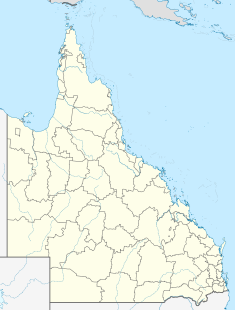Webber House, Brisbane
| Webber House | |
|---|---|

Webber House
|
|
| Location | 439 Ann Street, Brisbane City, City of Brisbane, Queensland, Australia |
| Coordinates | 27°27′48″S 153°01′50″E / 27.4632°S 153.0305°ECoordinates: 27°27′48″S 153°01′50″E / 27.4632°S 153.0305°E |
| Design period | 1900 - 1914 (early 20th century) |
| Built | 1904 |
| Architect | John Smith Murdoch, Robin Dods |
| Architectural style(s) | Arts & Crafts |
| Official name: Webber House, Cathedral Schools and St John's Institute | |
| Type | state heritage (built) |
| Designated | 21 October 1992 |
| Reference no. | 600079 |
| Significant period | 1904 (fabric) 1936-1941, 1941-1945 (historical) |
| Significant components | hall - assembly |
| Builders | Worley & Whitehead |
Webber House is a heritage-listed former school and present-day church hall at 439 Ann Street, Brisbane City, City of Brisbane, Queensland, Australia. It sits within the grounds of St John's Cathedral, Brisbane. It was designed by John Smith Murdoch and Robin Dods and built in 1904 by Worley & Whitehead. It is also known as Cathedral Schools and St John's Institute. It was added to the Queensland Heritage Register on 21 October 1992.
In 1899 the Anglican Diocese of Brisbane acquired property in Ann Street for the construction of St John's Cathedral, a day school and Church Institute. It was constructed by Worley and Whitehead of Ipswich to a joint design of John S Murdoch and the diocesan architect Robin S Dods. Murdoch, who was an architect for the State Works Department (1894-1903) took leave of absence to design Webber House and also St Luke's Church of England in Charlotte Street.
Stone from St John's Pro-Cathedral in William Street (demolished in 1904) was re-used for the foundation stones, and in the front and rear walls. The main doors, most of the gothic style windows and the roof trusses were also re-used.
The ground floor contained the assembly hall and at the rear were two covered playsheds. The second floor included the institute reading room, two schoolrooms and the teachers' room. The top storey was one large room for the institute. In all, accommodation was provided for 300 children.
The Sisters of the Sacred Advent conducted a school in the premises from 1936 until 1941. During the Second World War the building was occupied by the Australian Army Engineering Corps and the Army Medical Department and was subsequently used for Cathedral activities and meeting hall.
...
Wikipedia


